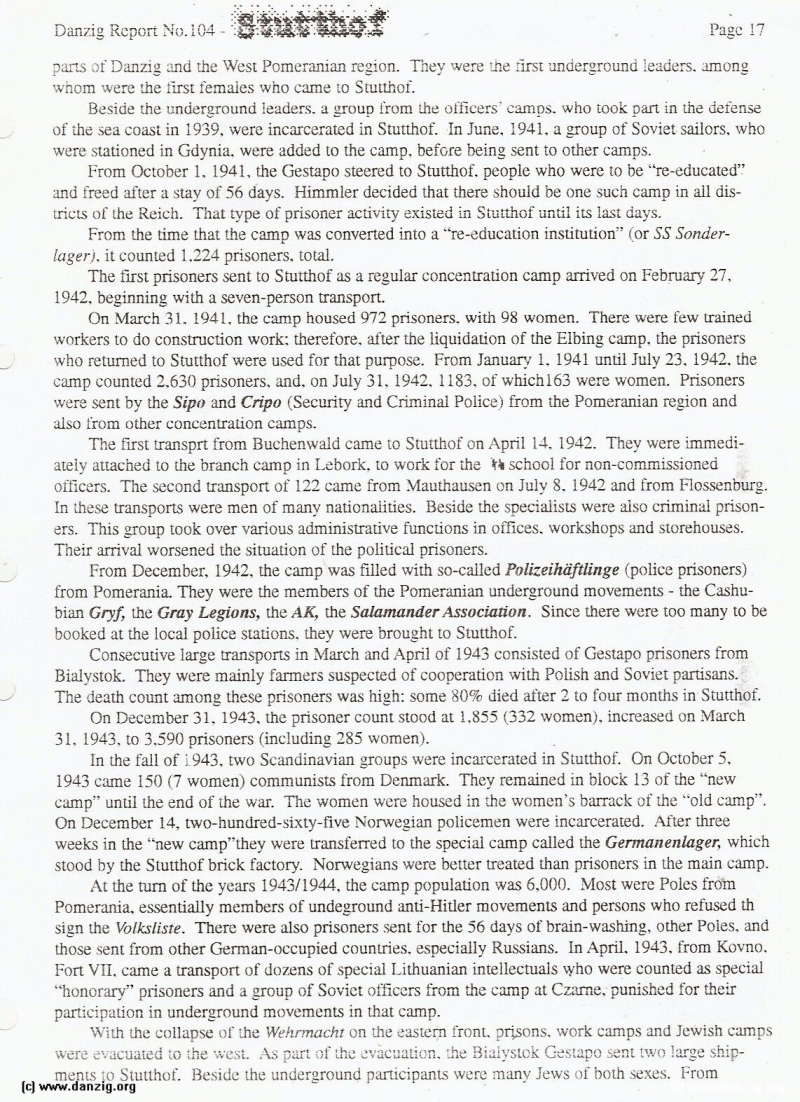
parts of Danzig and the West Pomeranian region. They were the rirst underground leaders, among whom were the tirst femaies who came to Stuithof.
Beside the underground leaders. a group from the offlcers’ camps, who took nart in the defense of the sea coast in 1939. were incarcerated in Stutthof. In June. 1941. a group of Soviet sailors, who were stationed in Gdynia. were added to the camp. before being sent to other camps.
From October 1. 1941. the Gestapo steered to Stutthof. people who were to be “re-educated” and freed after a stay of 56 days. Himmler decided that there should be one such camp in all disu -jets of the Reich. That type of prisoner activity existed in Stutthof until its last days.
From the time that the camp was converted into a “re-education institution” (or SS Sonderl ager). it counted 1.224 prisoners, total.
The first prisoners sent to Stutthof as a regular concentration camp arrived on February 27. 1942. beginning with a seven-person transport.
On March 31. 1941. the camp housed 972 prisoners, with 98 women. There were few trained workers to do construction work: therefore, after the liquidation of the Elbing camp. the prisoners who returned to Stutthof were used for that purpose. From January 1. 1941 until July 23, 1942. the camp counted 2.630 prisoners. and. on July 31. 1942. 1183. of whichl63 were women. Prisoners were sent by the Sipii and Cripo (Security and Criminal Police) from the Pomeranian region and also Irom other concentration camps.
The first transprt from Buchenwald came to Stutthof on April 14. 1942. They were immedia tely attached to the branch camp in Lebork. to work for the 4 school for non-commissioned officers. The second transport 01’ 122 came from Mauthausen on July 8. 1942 and from Flossenburg. In these transports were men of many nationalities. Beside the specialists were also criminal prisone rs. This group took over various administrative functions in offices, workshops and storehouses. Their arrival worsened the situation of the political prisoners.
From December. 1942. the camp was filled with so-called Polizeihdftlinge (police prisoners) from Pomerania. They were the members of the Pomeranian underground movements - the Cashub ian Gryf, the Gray Legions, the AK, the Salamander Association. Since there were too many to be booked at the local police stations. they were brought to Stutthof.
Consecutive large transports in March and April of 1943 consisted of Gestapo prisoners from Bialystok. They were mainly farmers suspected of cooperation with Polish and Soviet partisans. The death count among these prisoners was high: some 0% died after 2 to four months in Stutthof.
On December 31. 1943. the prisoner count stood at 1.855 (332 women), increased on March 31. 1943. to 3.590 prisoners (including 285 women).
In the fall of i943. two Scandinavian groups were incarcerated in Stutthof. On October 5. 1943 caine 150 (7 women) communists from Denmark. They remained in block 13 of the “new camp” until the end of the war. The women were housed in the women’s barrack of the “old camp”. On December 14, two-hundred-sixty-five Norwegian policemen were incarcerated. After three weeks in the “new carnp”thev were transferred to the special camp called the Germanenlager. which stood by the Stutthof brick factory. Norwegians were better treated than prisoners in the main camp.
At the turn of the years 1943/1944. the camp population was 6.000. Most were Poles frotn Pomerania. essentially members of undeground anti-Hitler movements and persons who refused th sign the Voiksliste. There were also prisoners sent for the 56 days 01’ brain-washing, other Poles, and those sent from other German-occupied countries, especially Russians. In April. 1943. from Kovno. Fort VII. came a transport of dozens of special Lithuanian intellectuals who were counted as special “honorary” prisoners and a group of Soviet officers from the camp at Czarne, punished for their participation in underground movements in that camp.
With the collapse of the Wehrmacht on the eastern front, pij.sons. work camps and Jewish camps were evacuated o the west. .•s part of the vacuation. the i3ialvswk Gestapo sent two large shipm ents to Stutthof. Beside the underground participants were many Jews of both sexes. From
Danzig Report Vol. 1 - Nr. 104 - July - August - September - 1999, Page 17.
Hits: 3533
Added: 25/07/2015
Copyright: 2025 Danzig.org

